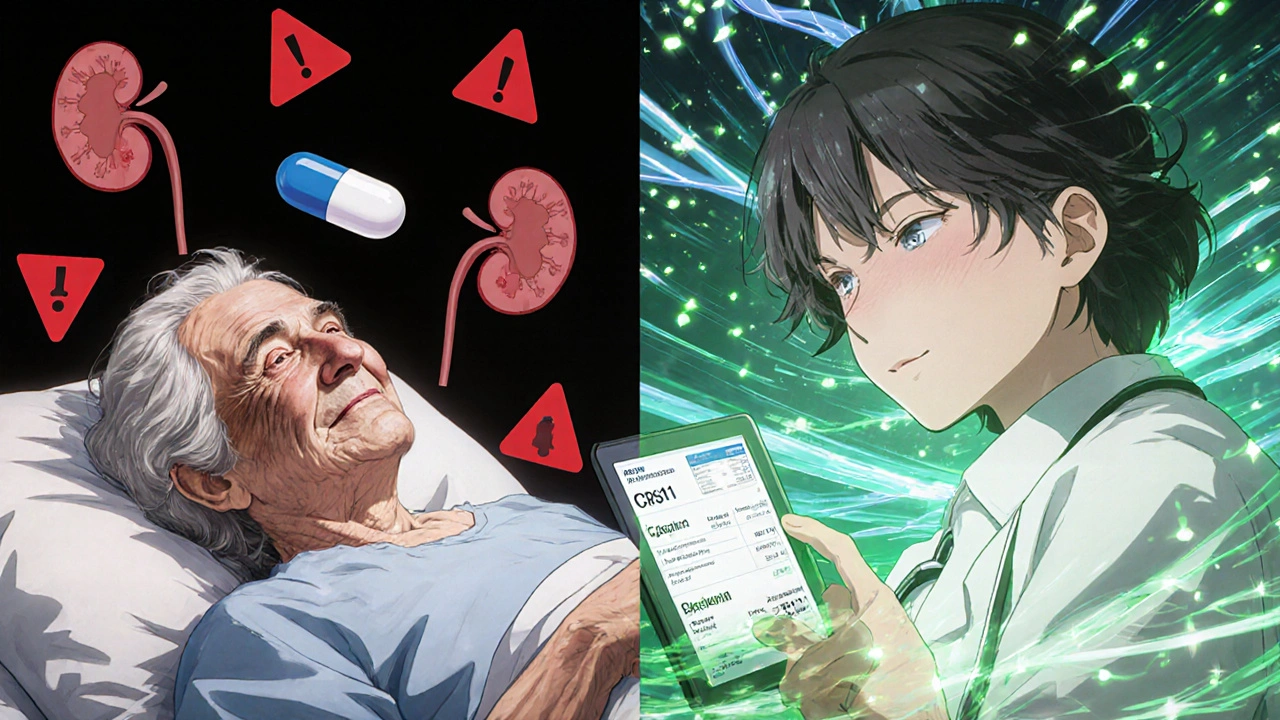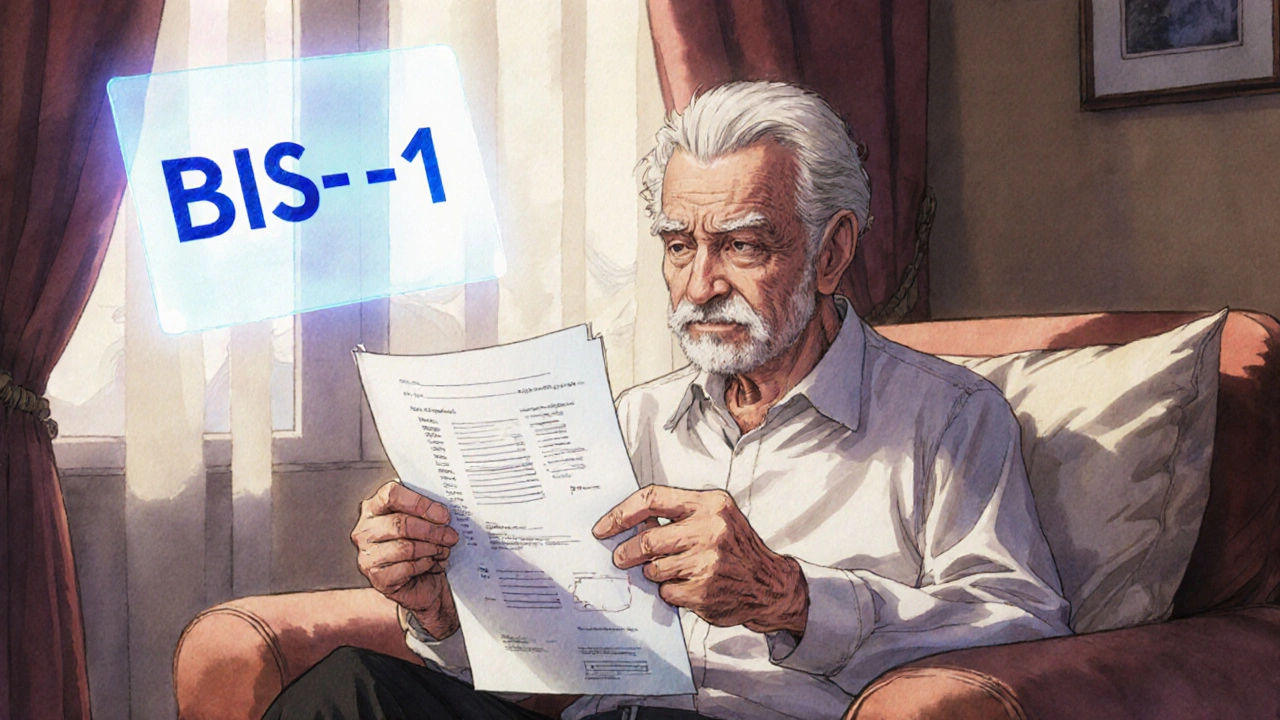When you’re over 70, taking the same dose of a medication you took at 40 can be dangerous-not because the drug changed, but because your kidneys didn’t keep up. As we age, kidney function naturally drops. By age 80, many people have lost nearly 40% of their kidney filtering capacity compared to their 30s. Yet, most prescription labels still list one standard dose. That’s where things go wrong. About 30% of common medications for seniors-like painkillers, blood thinners, and antibiotics-are cleared by the kidneys. If those kidneys aren’t working as well as they used to, drugs build up. That’s how you get confusion, falls, bleeding, or even kidney failure from a pill meant to help.
Why Kidney Function Changes With Age
Your kidneys don’t just slow down-they shrink. The number of filtering units, called nephrons, declines by about 1% each year after age 40. Blood flow to the kidneys drops too. That means less drug gets filtered out. A 75-year-old with no diabetes or high blood pressure might have an eGFR of 60 mL/min/1.73 m². That’s not disease. That’s normal aging. But if you’re prescribed a drug like warfarin or gabapentin based on a 25-year-old’s kidney numbers, you’re at risk. The problem isn’t just old age. It’s assuming old age doesn’t change how drugs work.The Equations That Matter (And Which Ones to Avoid)
Doctors use formulas to estimate kidney function. But not all formulas work well for seniors. The most common one you’ll hear about is CKD-EPI. It’s the default in most electronic health records. But for someone over 75, especially if they’re thin, frail, or have low muscle mass, CKD-EPI often says their kidneys are working better than they actually are. Why? Because it’s based on creatinine, a waste product made by muscle. Less muscle = less creatinine = falsely high eGFR. That’s dangerous. The Cockcroft-Gault formula, even though it’s older, often does better for seniors-if you use the right weight. Use ideal body weight, not actual weight. For example, if someone is 80 kg but only 1.55 meters tall and frail, their actual weight overstates kidney function. Using ideal body weight cuts dosing errors by up to 25%. Many pharmacists in nursing homes already do this. But most doctors don’t. For people over 75, especially those with low muscle or poor nutrition, the BIS1 and FAS equations are more accurate. BIS1 was developed specifically for older adults. In a study of 85-year-olds, BIS1 was correct within 30% of the real kidney function 95% of the time. CKD-EPI? Only 78%. That’s a huge gap when you’re dosing a drug like dabigatran, where a 10% error can mean bleeding or a stroke.What to Test and When
Don’t rely on one number. Here’s what you need:- Serum creatinine: The standard test. But alone, it’s misleading in seniors.
- eGFR: Calculated from creatinine. Use BIS1 for patients over 75. If your doctor uses CKD-EPI, ask why.
- Serum cystatin C: A better marker for kidney function in low-muscle seniors. It’s not affected by muscle mass. Costs $50-$75 more, but worth it if creatinine looks normal but the patient is frail.
- Urine albumin-to-creatinine ratio: Checks for early kidney damage. Important if the patient has diabetes or high blood pressure.
- 24-hour urine collection: The gold standard for creatinine clearance. Rarely used, but necessary before starting high-risk drugs like aminoglycosides or colistin.
Screening should happen at least once a year for seniors on regular meds. If they’re admitted to the hospital, test again. Acute kidney injury affects 30-40% of older hospital patients-and it can happen in days. A simple blood test before giving a new drug can prevent disaster.

Real Cases: When the Numbers Lie
A 91-year-old woman with dementia was prescribed rivaroxaban for atrial fibrillation. Her creatinine was 1.1 mg/dL. Her doctor used CKD-EPI: eGFR 58 mL/min/1.73 m². That’s “mild” kidney disease. She got the standard dose. Two weeks later, she bled internally. Her actual kidney function, measured with cystatin C and BIS1, was 32 mL/min/1.73 m². She needed a quarter of the dose. The CKD-EPI number was wrong by 26 points. That’s not a rounding error. That’s life or death. Another case: an 83-year-old man with Parkinson’s and weight loss. His creatinine was 0.8 mg/dL. CKD-EPI said his kidneys were fine. But he was losing muscle fast. His BIS1 eGFR was 41. He was on gabapentin for nerve pain. His doctor switched him to a lower dose after seeing the BIS1 result. He stopped stumbling. His confusion cleared up. He wasn’t overdosed-he was undermedicated because the system misread his kidneys.What You Can Do
If you or a loved one is on multiple medications:- Ask your doctor: “Which equation did you use to calculate my kidney function?”
- If they say “CKD-EPI,” ask: “Should I use BIS1 instead, given my age and build?”
- Request a cystatin C test if you’re frail, underweight, or have no muscle mass.
- Check your prescription labels. Do they say “adjust for kidney function”? If not, ask the pharmacist.
- Keep a list of all your meds and share it with every doctor. Many seniors take 8-10 drugs. Each one adds risk.
Pharmacists are your allies. In long-term care, 78% of them adjust doses based on BIS1 or ideal body weight. But they can’t help if the doctor doesn’t give them the right numbers. Don’t assume the computer got it right. Ask.

What’s Changing in 2025
New tools are coming. Epic and other major electronic health record systems now automatically use BIS1 for patients over 75. That’s huge. But not all clinics have updated their systems. The FDA now requires drug makers to list dosing guidelines using multiple equations. The National Institute on Aging is funding a $4.2 million project to create faster, more accurate point-of-care kidney tests for seniors. And a new equation, CKD2024, combines creatinine and cystatin C with age-specific math-it’s showing 15% better accuracy in people over 80.Still, the biggest barrier isn’t technology. It’s awareness. A 2023 survey found that 65% of primary care doctors don’t know which equation to use for seniors. They just use whatever the computer picks. That’s why so many seniors get the wrong dose. The fix isn’t a new drug. It’s a new question: “What’s my real kidney function?”
When to Worry
Watch for these signs after starting a new med:- Confusion or memory lapses
- Frequent falls or dizziness
- Nausea, loss of appetite, or swelling in ankles
- Unusual bruising or bleeding
If you see any of these, call your doctor. Don’t wait. It could be a kidney issue.
Final Thought
Your kidneys don’t age the same way your eyes or joints do. They’re not just slower-they’re misunderstood. A creatinine level that looks normal might be hiding serious underfunction. A dose that’s “standard” might be too high. The safest approach isn’t guessing. It’s measuring accurately. For seniors, safe dosing isn’t about following a label. It’s about knowing your body’s real capacity to clear the drug. That’s not magic. It’s science. And it’s available right now-if you know what to ask for.How often should seniors get their kidney function checked?
Seniors on regular medications should have their kidney function checked at least once a year. If they’re over 75, have diabetes or high blood pressure, or are starting a new drug-especially one cleared by the kidneys-check it before starting and again after 2-4 weeks. Hospitalization is another red flag. Kidney function can drop fast in older adults during illness, so retesting is critical.
Is CKD-EPI bad for seniors?
Not always. CKD-EPI works well for most adults under 75. But for seniors over 75-especially those who are frail, underweight, or have low muscle mass-it often overestimates kidney function. That’s because it relies on creatinine, which comes from muscle. Less muscle = lower creatinine = falsely high eGFR. That can lead to dangerous overdosing. For this group, BIS1 or FAS are better choices.
Why does ideal body weight matter in the Cockcroft-Gault formula?
The Cockcroft-Gault formula uses weight to estimate kidney clearance. But if someone is overweight or obese, their actual weight includes fat, not muscle. Fat doesn’t produce creatinine. Using actual weight makes the formula think their kidneys are working better than they are. Using ideal body weight (based on height and gender) gives a more accurate picture. Studies show this cuts dosing errors by 25% in older adults.
Can I trust the eGFR number on my blood test report?
Not always. Most labs use CKD-EPI by default, even for seniors. That number might be inaccurate if you’re frail or have low muscle mass. Always ask: “Which equation was used?” and “Should I get a cystatin C test too?” If your doctor doesn’t know, bring up BIS1. It’s becoming the standard in geriatric care.
What drugs are most risky for seniors with reduced kidney function?
High-risk drugs include blood thinners like dabigatran and rivaroxaban, painkillers like gabapentin and pregabalin, antibiotics like vancomycin and aminoglycosides, and diuretics like furosemide. These are cleared mostly by the kidneys. Even small errors in dosing can lead to bleeding, confusion, kidney damage, or falls. Always check if the drug label says “adjust for kidney function.” If not, ask your pharmacist.
Are there free tools to calculate kidney function for seniors?
Yes. The National Kidney Foundation has a free online eGFR calculator updated for 2023 that lets you choose between CKD-EPI, MDRD, and Cockcroft-Gault. The American Geriatrics Society also offers a free clinical toolkit called “Kidney Function Assessment in Older Adults,” which includes step-by-step guidance on selecting the right equation and adjusting doses. Both are available at no cost.








vinod mali
Been managing my dad's meds for years. CKD-EPI gave us false confidence until we switched to BIS1. His creatinine looked fine but he was falling constantly. After the correction? He started walking again. Simple test. Huge difference.
Jennie Zhu
It is imperative to underscore the clinical significance of renal pharmacokinetic dynamics in the geriatric population. The overreliance upon serum creatinine-derived estimated glomerular filtration rate (eGFR) algorithms, particularly CKD-EPI, introduces a systematic bias attributable to diminished skeletal muscle mass, thereby precipitating iatrogenic toxicity.
Kathy Grant
I used to think aging was just about wrinkles and slow walks. Then I watched my mom nearly die from a ‘standard’ dose of gabapentin. Her kidneys weren’t broken-they were just invisible to the system. The real tragedy isn’t the drug. It’s that we treat bodies like machines with one-size-fits-all settings. We forget: people aren’t data points. They’re people. And their bodies change. Not because they’re failing-but because they’re living. We need to see them. Really see them. Not just the numbers the computer spits out.
Robert Merril
Dude the whole post is just a fancy way of saying doctors are lazy and computers are dumb. I got my eGFR from my phone app last week and it said 47. My doctor said it was fine. I told him to check cystatin C. He rolled his eyes. Two weeks later I was in the ER. Now he sends me his notes. I’m not mad. Just tired. #OverIt
Noel Molina Mattinez
Why are you even talking about BIS1? The real issue is Big Pharma doesn't want you to know they design drugs for 30-year-old men. That’s why your grandma gets confused on painkillers. They don't test on old people. They test on college kids. Then they sell it to everyone. Wake up.
Roberta Colombin
Thank you for sharing this. Many families are unaware that kidney function changes naturally with age. It’s not illness-it’s just how bodies evolve. I encourage everyone to speak with their pharmacist. They know more than you think. And never be afraid to ask, ‘What’s the safest dose for my body?’
Dave Feland
Let’s be clear: the FDA and AMA are complicit in this systemic negligence. The medical establishment has spent decades promoting CKD-EPI because it’s cheaper, faster, and aligns with corporate EHR vendors. BIS1? Too nuanced. Too expensive. Too inconvenient. Meanwhile, seniors are being quietly poisoned by algorithmic arrogance. This isn’t medical error-it’s institutional malpractice.
Ashley Unknown
I’m not just talking about my aunt. I’m talking about the entire system. They gave her rivaroxaban. She bled for three days. No one knew why. Then I found this article. I printed it. I showed it to three doctors. One laughed. One cried. One said ‘I didn’t know that.’ I had to fight to get her cystatin C tested. The hospital charged me $80. They didn’t even offer to help. Now I’m starting a nonprofit. Because if I don’t, who will? My mom’s next. And my dad. And your grandma. We’re all one lab report away from disaster.
Georgia Green
My mom’s creatinine was 0.9. eGFR 62. She was on gabapentin. She couldn’t walk straight. I asked for cystatin C. Result: eGFR 38. Dose cut in half. She’s back to reading books. I’m not a doctor. I’m just a daughter who googled too much. Please, if you’re on meds-ask. Even if you sound dumb. It’s worth it.
Christina Abellar
Always ask what equation was used. It’s the easiest thing to do and it saves lives.
Eva Vega
The use of cystatin C as a biomarker in geriatric pharmacokinetics provides a more accurate reflection of glomerular filtration rate independent of lean body mass, thereby mitigating the risk of underdosing or overdosing in frail elderly populations. CKD-EPI’s reliance on creatinine introduces significant bias in low-muscle phenotypes.
Matt Wells
The assertion that Cockcroft-Gault with ideal body weight improves outcomes is statistically sound but clinically impractical. The variance in ideal body weight estimation introduces its own confounding variables, particularly in populations with fluctuating nutritional status. A prospective, randomized trial controlling for BMI, serum albumin, and sarcopenia index is required before institutional adoption.
Margo Utomo
YES. 🙌 My uncle was on warfarin. CKD-EPI said he was fine. Cystatin C said he was at risk. Dose adjusted. No more blackouts. Pharmacist saved his life. Tell your doctor to talk to the pharmacist. They’re the real heroes. 💪❤️
George Gaitara
Why are we still having this conversation in 2025? This article should be required reading in med school. Instead, we have doctors who think ‘eGFR’ is a brand of coffee. The system is broken. And it’s not just about kidney function. It’s about respect. We treat seniors like they’re already ghosts. But they’re still here. And they deserve better than a computer’s guess.